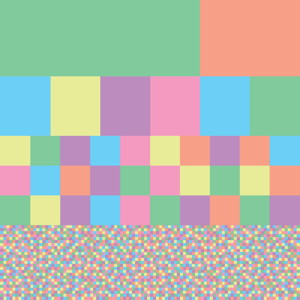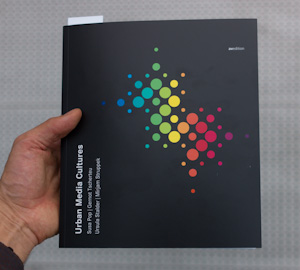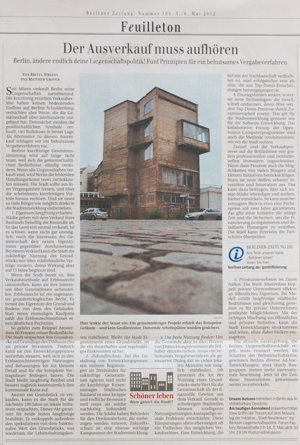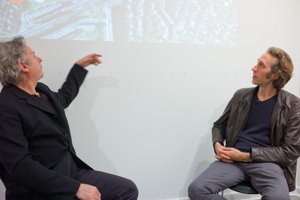Legal structure as a design instrument
- Written by: Matthew Griffin |
- Created: Tuesday, 22 November 2016 11:13

This article deals with the evolving relationship between architecture and legislation based on our experience as architects and our work on Frizz23, one of the three projects selected for the three PxB sites surrounding the Blumengroßmarkt.
As architects operating beyond the envelope of traditional practice, we see no difference between solving a design problem, and resolving pre-structural issues like the legal fabric this article focuses on.
The attached diagram shows the different layers of interaction between the network of actors involved in Project Frizz23, and the pertinent legislation. We pursued different strategies within each layer to either make the law conform to the project, or make the project conform to the law.
1. Actively changing Legislation

Working as participants within the Initiative Stadt Neudenken we have helped structure Berlin's legislation for public land sales by means of a broad dialogue between civil society and government institutions. The processes that lie behind changing legislation are incremental and slow. The negotiations at the Rundentisch zur Liegenschaftspolitik which began in 2012 are progressing, but much is yet to be accomplished.
The land sales procedure established for the three PxB sites is a critical milestone in the process of changing Berlin's Liegenschaftspolitik. The pilot procedure evolved, was refined step by step, and culminated in an exhibition and public workshop that informed the selection of the best project for each site. As a case study it informs and inspires the ongoing work to improve Berlin's legislation governing public land sales.
Changing legislation takes longer than the design and construction phases of a building. As architects we are usually confined to working within the existing legal framework, contributing to incremental change by providing innovative examples.
2. Developing references for future Legislation
The three projects that the jury selected to buy the three sites were all based on innovative cooperative development models led by architects. State regulations specified that a requirement for an architectural competition be written into the land sale contract. We proposed a new dialogue oriented alternative, and together with all stakeholders negotiated a change in the contracts.

This Qualifizierende Verfahren (qualifying procedure) spanned four workshops and 18 months in which the state and district urban planing departments, three invited external architects, representatives of local initiatives, and the clients and architects of the three sites criticized and encouraged the successively evolving designs. This intense dialogue provided a unique non competitive framework to assure architectural quality, and build consensus and support for the proposals. It promoted deep interaction between the stakeholders and architects as the projects evolved. The process created an environment that fostered outstanding participative design.
This Qualifizierende Verfahren precedent serves as a reference for adapting legislation to encourage dialogue oriented design as a viable, co-operative alternative to an architectural competition.
3. Expanding the envelope of existing legislation
The Qualifizierende Verfahren gave us the chance to explore the architectural potential beyond the envelope specified by the Bebauungsplan. During the workshops we were able to draw on a broad panel of experts to help negotiate exceptions that would have been difficult under normal circumstances.

To realize the Frizz23 building as planned, we needed seven significant exceptions from the Bebauungsplan. The most visible of which was permission to substantially exceed height requirements so we could create the project's distinctive silhouette by redistributing the permissible floor area.
Economically driven projects do not normally seek exceptions to these laws because of the time required and the risk involved. This tends to foster to buildings defined primarily by regulations instead of expressing richer architectural priorities.
4. Designing legal structures to accommodate architectural potential
To make Frizz23 possible, we created a two tiered ownership structure.

The outer layer was a building co-operative consisting of three separate sites for three companies, each with its own distinct ownership structure: Forum Berufsbildung e.V. a charitable company specialized in education, Miniloft Kreuzberg GbR in which were engaged as owners in addition to our role as architects, and FrizzZwanzig GbR a building co-operative that we founded to shoulder the lions share of the project.
To include Forum Berufsbildung e.V. in the project, we needed to comply with the complex and strict legislation governing charitable organizations. We consulted several experts to help us define a structure at the intersection of tax, ownership and planning law that would make the building possible.
The architecture is an expression of this complex ownership structure – Einteilig, Dreiteilig Kleinteilig (single-, triple-, multifaceted)
5. Legislation adapting to design
The co-operative Baugruppen projects developed by architects exploring new models for architectural production have exposed cracks in existing German legislation.

The courts have asked the federal government to redefine property purchase tax laws to cover the specifics of the Baugruppen model. Working with experts we established a contract for FrizzZwanzig GbR not only as the basis upon which to create a community, but also to minimize the risk involved. One major challenge in this is to design for yet unknown changes in projected legislation which will happen soon after construction is completed, and which may affect the project.
When a project steps beyond the standard models, designing the legal structures is a challenge often left to lawyers. By exploring the potential of the legal framework as a design instrument, architects can expand their radius of action, and gain more control of their work.
This post began as a proposal for the legislating architecture issue of ARCH+
Historicism is anything but harmless!
- Written by: Britta Jürgens |
- Created: Tuesday, 04 June 2013 10:50
 As an art, architecture must always reflect its Zeitgeist. Now that the construction of a
partial imitation of Berlin's destroyed palace has begun, we are witnessing an aggressive
attempt to establish historicized facades as the only legitimate approach to our city.
As an art, architecture must always reflect its Zeitgeist. Now that the construction of a
partial imitation of Berlin's destroyed palace has begun, we are witnessing an aggressive
attempt to establish historicized facades as the only legitimate approach to our city.
Together
- Written by: Matthew Griffin |
- Created: Monday, 06 May 2013 12:36
 Be a part of FRIZZ23 and create your new workspace together with us in the center of Berlin.
Be a part of FRIZZ23 and create your new workspace together with us in the center of Berlin.
Crowdfunding Buildings
- Written by: Matthew Griffin |
- Created: Friday, 11 January 2013 17:29
 The wave of change brought about by the internet is now hitting the shores of real
estate finance. Crowdfunding can help us make our cities more malleable, more
responsive and more distinct. If regulatory bodies can find a way to unleash its
potential and minimize risk of abuse, crowdfunding could give communities a real
say in how their neighborhoods evolve.
The wave of change brought about by the internet is now hitting the shores of real
estate finance. Crowdfunding can help us make our cities more malleable, more
responsive and more distinct. If regulatory bodies can find a way to unleash its
potential and minimize risk of abuse, crowdfunding could give communities a real
say in how their neighborhoods evolve.
Do we need a land reform?
- Written by: Matthew Griffin |
- Created: Tuesday, 27 November 2012 15:25

Do It Yourself-International Building Exhibition
- Written by: Matthew Griffin |
- Created: Thursday, 13 September 2012 15:20
 In Berlin, the planned city is being complemented by a city of initiatives, a city where
urban innovation is driven by a dynamic biosphere of artists, activists and
entrepreneurs. Berliners are creating their city.
In Berlin, the planned city is being complemented by a city of initiatives, a city where
urban innovation is driven by a dynamic biosphere of artists, activists and
entrepreneurs. Berliners are creating their city.
Urban Media Cultures
- Written by: Matthew Griffin |
- Created: Wednesday, 22 August 2012 13:07
 Media façades are a disruptive technology that could potentially redefine how we experience
cities, and how we define places.
This article was just published in the book Urban Media Cultures. It explores the potential
implications of media façades on future urban development.
Media façades are a disruptive technology that could potentially redefine how we experience
cities, and how we define places.
This article was just published in the book Urban Media Cultures. It explores the potential
implications of media façades on future urban development.
Guggenheim LAB
- Written by: Matthew Griffin |
- Created: Monday, 02 July 2012 13:08
 The Guggenheim LAB has been providing a platform for ideas surrounding urban development in Berlin.
The Guggenheim LAB has been providing a platform for ideas surrounding urban development in Berlin.
Conversations: Madeleine von Mohl
- Written by: Britta Jürgens |
- Created: Wednesday, 06 June 2012 15:21
 We are an analogue space for all the
digital bohemians who finally have a place to meet. Our role is to create community.
We are an analogue space for all the
digital bohemians who finally have a place to meet. Our role is to create community.
Printed!
- Written by: Matthew Griffin |
- Created: Wednesday, 09 May 2012 16:05
 Locally Grown City's first foray into traditional media was published on Saturday May 5th in the Berliner Zeitung.
Locally Grown City's first foray into traditional media was published on Saturday May 5th in the Berliner Zeitung.
Stories behind projects: Edouard Francois - Matthew Griffin
- Written by: Matthew Griffin |
- Created: Tuesday, 24 April 2012 12:13
 Architecture is decoration with holes. This building separates the decoration from the holes
Architecture is decoration with holes. This building separates the decoration from the holes
Read more: Stories behind projects: Edouard Francois - Matthew Griffin
Productive Patenschaft
- Written by: Matthew Griffin |
- Created: Tuesday, 27 March 2012 15:13
 Organizations of different scales and means should work together to create dense and vibrant developments.
Organizations of different scales and means should work together to create dense and vibrant developments.
Tender Tender
- Written by: Matthew Griffin |
- Created: Friday, 09 March 2012 17:28
 Five principles to help people get directly involved in urban development, for
the long term benefit of the city and its citizens.
Five principles to help people get directly involved in urban development, for
the long term benefit of the city and its citizens.
The Tripod System
- Written by: Matthew Griffin |
- Created: Monday, 20 February 2012 14:55
 a Mixed Ownership Development Model that combines three different ownership forms in one building.
a Mixed Ownership Development Model that combines three different ownership forms in one building.
Start-Up City
- Written by: Matthew Griffin |
- Created: Thursday, 26 January 2012 19:00
 Entrepreneurship is a fundamental component of humanity's creative and transformative drive. It shapes societies, and plays an essential role in how cities change.
Entrepreneurship is a fundamental component of humanity's creative and transformative drive. It shapes societies, and plays an essential role in how cities change.
Initiative Map
- Written by: Matthew Griffin |
- Created: Monday, 09 January 2012 14:17
 As one of his last acts in office, Ephraim Gothe, Mitte's Councillor for Urban Development, has created a map of all the local initiatives in his constituency. Encouraging local citizen engagement could radically transform Berlin - this is a good first step.
As one of his last acts in office, Ephraim Gothe, Mitte's Councillor for Urban Development, has created a map of all the local initiatives in his constituency. Encouraging local citizen engagement could radically transform Berlin - this is a good first step.
Berlin – Gap City
- Written by: Matthew Griffin |
- Created: Thursday, 15 December 2011 15:28
 Communism's seismic collapse created a fault line of physical, cultural, and economic gaps that have defined Berlin.
Communism's seismic collapse created a fault line of physical, cultural, and economic gaps that have defined Berlin.
Prestructures and Practice: Expanding Architecture
- Written by: Matthew Griffin |
- Created: Monday, 31 October 2011 14:33

Architecture, more than any other art form, is influenced by social, economic, technical and physical structures beyond the control of the architect. These can be called prestructures and they are the matrix within which the architect works.
Read more: Prestructures and Practice: Expanding Architecture
What is a Locally Grown Project?
- Written by: Matthew Griffin |
- Created: Monday, 17 October 2011 12:48

This blog examines specific examples in Berlin. It describes the nuts and bolts of projects that have interacted with urban development to create an inspiring city. It explores the intersection of culture, entrepreneurship and architecture and sets this out in a piecemeal manner, which is also how the projects themselves thrive.
Introduction to the Locally Grown City blog
- Written by: Matthew Griffin |
- Created: Tuesday, 04 October 2011 12:34

This blog aims to inspire you to engage yourself with your city.
It is based on our personal experience in Berlin, and focuses on the creative work behind the projects and places that make Berlin such a fascinating city.
Locally Grown City
- Written by: Matthew Griffin |
- Created: Wednesday, 28 September 2011 17:56

We see our practice as a multifaceted field of action that revolves around the city. Our own 'doing' is a testing ground for new ways to influence the urban and social structure that makes our cities tick.